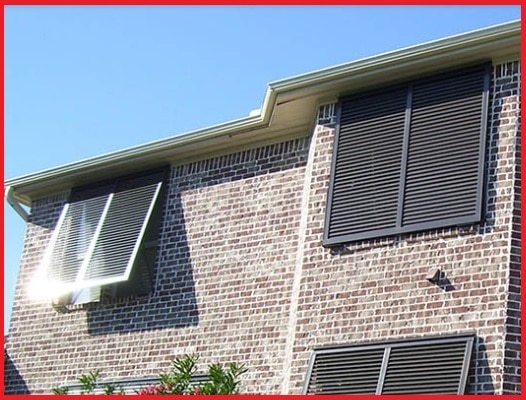Is your home ever ready for the storm season ? Your doors and windows are particularly prone to the forces of wind, debris, and heavy rain. Adequate window and door protection in the form of storm windows or hurricane shutters is important for keeping your family and your home safe and secure. Hurricane shutters are the most flexible and common type of hurricane protection due to their versatility, strength, and affordability.
However, the same and common question stays: How do I opt to choose the appropriate hurricane shutters for my home? The answer, this depends on what you’re searching for. Here are five common types of hurricane shutters with their corresponding pros and cons:
Accordion Shutters
These types of hurricane shutters are housed beside windows or doors. They unfold accordion-style during stormy weather.
Pros
Permanently affixed adjacent to the windows
Can be produced storm-ready easily by a single individual
Some models are locked with a key and considered as a theft defense
Cons
Appears bulky and out-of-place sometimes.
Have the capacity to easily break than other systems
Bahamas Hurricane Shutters
These louvered shutters are connected directly above windows and opened to provide shade and shelter for windows.
Pros
Permanently attached at the side of the windows
Can be quickly and easily made storm-ready by a single person
Gives permanent shade and privacy
Cons
Traditionally weaker than any other systems
They hamper too much light
Design limits their use and function
Rolling Shutters
These affix above windows and roll up in an enclosed box. They are lowered manually with a hand crank or with a push-button automatically and naturally.
Pros
Permanently attached above windows
Conveniently assembled for storms by a single person
Offers arguably excellent protection
Cons
Considered as the most expensive shutter system
Push-button-operated shutters require and demand battery backup
Hurricane Panels
These steel or aluminum shutters are connected to the walls around the windows together with the doors on bolts. They are corrugated, with each piece overlapping the next to give the utmost and maximum strength.
Pros
The cheapest permanent shutter
Removable, so it doesn’t alter the overall appearance of the home
Durable and gives the best protection for doors and windows
Cons
Needs storage
Can be hard to handle
With sharp edges
Doesn’t line up properly occasionally
Hurricane Fabric Screens
Constructed of semi-porous polypropylene fabric these systems are easily modified to fit a wide variety of openings such as arches, trapezoids and even circular shapes. Hurricane fabric can be mounted in tracks or directly attached to structural members surrounding the opening.
Pros
Has category 5 wind load tested
Lightweight and manageable to deploy
100% ultraviolet rays resistant
Can be easily installed by a single person
Affordable price
Cons
Vulnerable and susceptible to scratches and therefore, not as long-lasting
Can become fogged
Nonetheless, the right hurricane shutter for you surely depends largely on what you’re looking for and what you can afford to purchase. Regardless of which type of hurricane shutter you select, you must have them appropriately installed by a professional.
Let Guardian Hurricane Protection, your Roll Down Shutters Expert in Naples help you with your shutter solution for any storm seasons. We have the professionals that have the necessary tools and experience to install your hurricane shutters, and will give you with unbeatable and affordable service the entire way or another for your Roll Down Shutters in Fort Myers.
Contact Guardian Hurricane Protection at 239-438-4732 / 239-244-2015 for faster response. For FREE CONSULTATION check us out athttp://bit.ly/guardianhurricaneprotection-contact, or you can visithttp://bit.ly/guardianhurricaneprotection-home for more details and services.
Bonus Topic: 2020 Hurricane Names For The Season
Do you ever wonder how storms are named? During the 1950s, meteorologists concluded that it was not easy to keep track of unnamed storms—particularly if there was more than one storm happening at any given time. By 1953, meteorologists around and across the United States were using names for tropical storms and cyclones.
The World Meteorological Organization is responsible for developing the names for both Northern Pacific and Atlantic storms. They use six lists of names for the Atlantic Ocean and Eastern North Pacific storms. These lists rotate one annually.
List of 2020 Atlantic Hurricane Names:
1.Arthur
2.Bertha
3.Cristobal
4.Dolly
5.Edouard
6.Fay
7.Gonzalo
8.Hanna
9.Isaias – pronounced “ees-ah-EE-ahs”
10.Josephine
11.Kyle
12.Laura
13.Marco
14.Nana
15.Omar
16.Paulette
17.Rene
18.Sally
19.Teddy
20.Vicky
21.Wilfred
Every six years, the names cycle back around and are used again (as in 2019). A hurricane that has devastating damage (Harvey, Katrina) is not used again but will be replaced by a different name beginning with the same letter.
Moreover, the names alternate between male and female names, in alphabetical and chronological order starting with A and omitting Q and U, X, Y, and Z. Lastly, if the names exceed more than 21 names during a season, the Greek alphabet is used.

